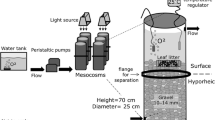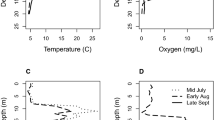Abstract
Diel migration patterns ofGonyaulax catenata andMesodinium rubrum in the central Baltic during spring 1986 are presented. The depth at which maximum cell concentration of these species occurred was dependent during daytime to a great degree on light intensity; it is hypothesized that the organisms migrated upwards toward higher light intensities until a certain threshold irradiance was reached, after which migration was directed downwards to avoid light intensities higher than the threshold. This threshold level probably depended on nutrient conditions and on the daily average of total irradiance of the foregoing days (light history). Furthermore, it is hypothesized that migration is an important mechanism for adapting to daily irradiance fluctuations. The dependence of migration on irradiance was more obvious forG. catenata than forM. rubrum.
Similar content being viewed by others
Literature cited
Blasco, D. (1978). Observations on the diel migration of marine dinoflagellates off the Baja California Coast. Mar. Biol. 46: 41–47
Crawford, D. W. (1989).Mesodinium rubrum: the phytoplankter that wasn't. Mar. Ecol. Prog. Ser. 58: 161–174
Cullen, J. J. (1985). Diel vertical migration by dinoflagellates: roles of carbohydrate metabolism and behavioral flexibility. In: Rankin, M. A. (ed.) Migration: mechanisms and adaptive significance. Contr. mar. Sci. Univ. Tex. 27: 135–152
Dale, T. (1987). Diel vertical distribution of planktonic ciliates in Lindaspollne, Western Norway. Mar. microb. Fd Webs 2: 15–28
Dybern, B. I., Hansen, H. P. (1989). Baltic Sea Patchiness Experiment. PEX-86, Part 1. General Report, Vols. 1 and 2. Cooperative Research Report 163. Int. Counc. Explor. Sea, Copenhagen
Eppley, R. W., Harrison, W. G. (1975). Physiological ecology ofGonyaulax polyedra, a red water dinoflagellate of southern California. In: LoCicero, V. R. (ed.) Proccedings of first international conference on toxic dinoflagellate blooms, 1974. Massachusetts Technology Foundation, Wakefield, Massachusetts, p. 11–23
Eppley, R. W., Holm-Hansen, O., Strickland, J. (1968). Some observations on the vertical migration of dinoflagellates. J. Phycol. 4: 333–340
George, D. G., Heaney, I. (1978). Factors influencing the spatial distribution of phytoplankton in a small productive lake. J. Ecol. 66: 133–135
Grasshoff, K. (ed.) (1976). Methods of seawater analyses. Verlag Chemie, Weinheim
Heaney, S. I., Eppley, R. W. (1981). Light, temperature and nitrogen as interacting factors affecting diel vertical migration of dinoflagellates in culture. J. Plankton Res. 3: 331–345
Holligan, P. M. (1985). Marine dinoflagellate blooms — growth strategies and environmental exploitation. In: Anderson, D. M., White, A. W., Baden, D. G. (eds.) Toxic dinoflagellates. Elsevier, New York, p. 133–140
Kahru, M., Leppänen, J.-M., Nômmann, S., Passow, U. (1990). Spatio-temporal mosaic of the phytoplankton spring bloom in the open Baltic Sea in 1986. Mar. Ecol. Prog. Ser. 66: 301–309
Kamykowski, D., McCollum, S. A. (1986). The temperature acclimatized swimming speed of selected marine dinoflagellates. J. Plankton Res. 8: 275–287
Kamykowski, D., Zentara, S.-J. (1976). The diurnal vertical migration of motile phytoplankton through temperature gradients. Limnol. Oceanogr. 22: 148–151
Kremling, K., Wenk, A. (1986). On the storage of dissolved inorganic phosphate, nitrate and reactive silicate in Atlantic Ocean water samples. Ber. dt. wiss. Kommn. Meeresforsch. 31: 69–74
Leppänen, J.-M., Brunn, J.-E. (1988). The role of pelagic ciliates including the autotrophicMesodinium rubrum during the spring bloom of 1982 in the open northern Baltic Proper. Ophelia (Suppl.) 4: 147–157
Lewis, M. R., Cullen, J. J., Platt, T: (1984a). Relationships between vertical mixing and photoadaptation of phytoplankton: similarity criteria. Mar. Ecol. Prog. Ser. 15: 141–149
Lewis, M. R., Horne, E. P. W., Cullen, I. J., Oakey, N. S., Platt, T. (1984b). Turbulent motions may control phytoplankton photosynthesis in the upper ocean. Nature, Lond. 311: 49–50
Lindahl, O. (1977). Studies on the production of phytoplankton and zooplankton in the Baltic in 1976, and a summary of results from 1973–1976. Meddelande fran Havsfiskelaboratoriet, Lysekil
Lindholm, T. (1981). On the ecology ofMesodinium rubrum (Lohmann) (Ciliata) in a stagnant brackish basin on Åland, SW Finland, Kieler Meeresforsch. (Sonderh.) 5: 117–123
Lindholm, T. (1985).Mesodinium rubrum — a unique photosynthetic ciliate. Adv. aquat. Microbiol. 3: 2–48
Lindholm, T., Mörk, A. C. (1990). Depth maxima ofMesodinium rubrum (Lohmann) Hamburger & Buddenbrock — examples from a stratified Baltic Sea inlet. Sarsia 75: 53–64
Marra, J. (1980). Vertical mixing and primary production. In: Falkowski, P. G. (ed.) Primary productivity in the sea. Plenum Press, New York p. 121–137
Packard, T. T., Blasco, D., Barber, R. T. (1978).Mesodinium rubrum in the Baja California upwelling system. In: Boje, R., Tomzak, M. (eds.) Upwelling ecosystems. Springer-Verlag, Berlin, p. 73–89
Passow, U. (1990). Vertikalverteilung und Sedimentation von Phytoplanktonarten in der mittleren Ostsee während des Frühjahrs 1986. Ber. Inst. MeeresK de Kiel 192: 1–203
Passow, U. (1991). Species-specific sedimentation and sinking velocities of diatoms. Mar. Biol. 108: 449–455
Rasmussen, J., Richardson, K. (1989). Response ofGonyaulax tamarensis to the presence of a pycnocline in an artificial water column. J. Plankton Res. 11: 747–762
Smith, W. O. Jr., Barber, T. R. (1979). A carbon budget for the autotrophic ciliateMesodinium rubrum. J. Phycol. 15: 27–33
Sorokin, Y. I., Kogelschatz, J. (1979). Analysis of heterotrophic microplankton in an upwelling area. Hydrobiologia 66: 195–208
Stoecker, D. K., Davis, L. H., Anderson, D. M. (1984). Fine scale spatial correlations between planktonic ciliates and dinoflagellates. J. Plankton Res. 6: 829–842
Therriault, J.-C., Booth, D., Legendre, L., Demers, S. (1990). Phytoplankton photoadaptation to vertical excursion as estimated by an in vivo fluorescence ratio. Mar. Ecol. Prog. Ser. 60: 97–111
Tyler, M. A., Seliger, H. H. (1981). Selection for a red tide organism: physiological responses to the physical environment. Limnol. Oceanogr. 26: 310–324
Utermöhl, H. (1931). Über das umgekehrte Mikroskop. Inter. Verein theor. angew. Limnol. 5: 567–596
Utermöhl, H. (1958). Zur Vervollkommnung der quantitativen Phytoplankton-Methodik. Mitt. int. Ver. Limnol. 9: 1–38
Wilkerson, F. P., Grunseich, G. (1990). Formation of blooms by the symbiotic ciliateMesodinium rubrum: the significance of nitrogen uptake. J. Plankton Res. 12: 973–989
Author information
Authors and Affiliations
Additional information
Communicated by O. Kinne, Oldendorf/Luhe
Rights and permissions
About this article
Cite this article
Passow, U. Vertical migration ofGonyaulax catenata andMesodinium rubrum . Mar. Biol. 110, 455–463 (1991). https://doi.org/10.1007/BF01344364
Accepted:
Issue Date:
DOI: https://doi.org/10.1007/BF01344364




